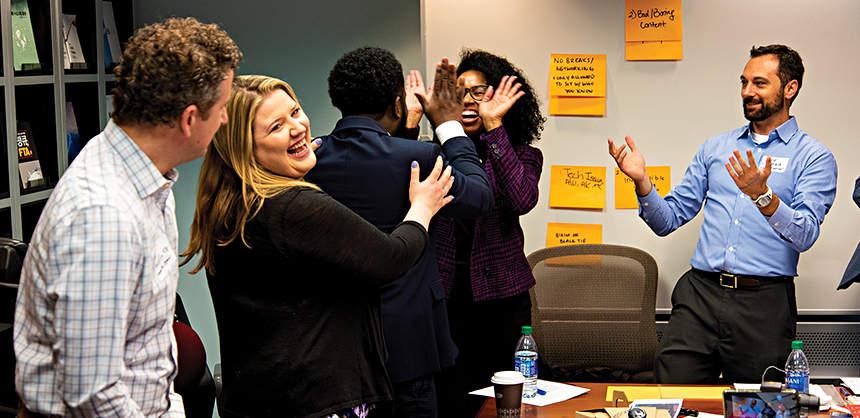Communicate & Connect: How To Develop Your Presentation SkillsMay 22, 2020
By Maura KellerCommunicate & Connect: How To Develop Your Presentation Skills

Becoming a memorable, engaging and effective presenter is part art and part science. In addition to being confident, eloquent and engaging, you also need to communicate the information at hand efficiently and effectively. Doing so can enhance a person’s reputation, boost their self-confidence and open up many professional opportunities.
Dianna Booher is founder of Booher Research Institute in Colleyville, Texas and one of the foremost authorities on corporate communication in America. She helps individuals and organizations communicate clearly and productively.
As Booher says, a decade ago, to most professionals a “presentation” meant someone standing on a stage speaking to a live audience. Today, a presentation may mean that same type of standard keynote, but it could also be an online presentation via a conference call piped into an executive retreat, a white-paper delivered by email, a podcast that audience members download and listen to at their leisure, or a pre-recorded video message simulcast to multiple audiences around the world.
“Even live presentations have changed significantly over the last decade or so,” Booher says. In past years, presentations primarily involved a speaker delivering either information or a motivational message to the audience. The information flowed only one way, from speaker to group, and the presentation typically was the same as the speaker had delivered to the prior audience and to the audience before that. And those speakers typically depended only on slides as visuals to reinforce their key points.
“But today, presentations are much more interactive — with audience members ‘talking back’ to the speaker, offering their own ideas, experiences and stories,” Booher says. “In addition to these speaker-audience ‘exchanges,’ speakers much more often deliver totally new or highly customized, rather than canned, presentations.” There is also an immersion into technological capabilities such as interactive audience polling, pre-assessments and reports done online, or post-presentation reinforcement delivered by email, podcast or phone apps.
However, Lee Gimpel, founder of Better Meetings in Washington, D.C., and a meeting expert with a focus on improving meetings by making them more productive, effective and engaging, says most presentations today are quite similar to how they’ve been 10 or 20 years ago — as we’re still very much in the age of PowerPoint and haven’t moved on from that.
“With the exception of using sleek laptops, powerful projectors and simple presentation software, the idea of someone standing in front of a room and lecturing to people — typically seated as they would be in a theater or classroom — is ages old,” Gimpel says. “I do, however, think that it’s much easier to see examples of great presentations today though, thanks largely to YouTube.”
It’s now very commonplace for people to watch recorded presentations in the vein of TED talks. On the plus side, as Gimpel explains, this gives people a viable model of what a good presentation looks like.
When we talk about presentation skills, Gimpel thinks most people first gravitate to thinking about the presentations they are most likely to have seen: One person standing in front of a room lecturing, probably with a projected slide deck.
“In that case, people are probably somewhat stuck thinking about how to make that style look or sound better rather than asking a more fundamental question: Am I even doing the right kind of presentation?” Gimpel says.
Therefore, Gimpel would advocate that potential presenters think less about their cadence, how much they smile and how snappy their opening joke is. “Instead, I’d advocate for skills that are perhaps more in line with what we know about groups and audience engagement in the 2020s,” Gimpel says.
Certainly, it’s important to speak up, to be concise, to smile, to make eye contact and to use appropriate visual aids, but Gimpel suggests the primary skill is first knowing if an hour-long lecture is the right kind of presentation.
“I’d want presenters to have a toolbox with a few different presentation formats they can deploy,” Gimpel says. “I’d want them to have skills to involve an audience beyond asking for questions in the last five minutes. I’d want them to be better at improv and less wedded to rote recitation. I’d want them to feel comfortable doing a Q&A rather than taking cues from a PowerPoint. I’d want them to have a few facilitation techniques to elicit questions or form small groups.”
Cherie Kerr, founder of ExecuProv in Santa Ana, California, a corporate presentation and communication skills training company, says effective presenters also need to have impeccable stage skills, such as proper breathing, solid vocal production and flawless diction.
“They should also have magnetic energy, spontaneity, self-expression, timing and be good listeners — for Q&A sessions,” Kerr says.” They must inspire the audience and motivate them. All presentations are either made to inform, educate or persuade. Sometimes, they overlap. It also helps if their content is entertaining to make the audience think long after the presentation is over.”
In Booher’s presentations coaching practice, most professionals tell her that they’ve had “presentations training” at some point in their career.
“As we discuss what they learned from that training, and as I video record them, I soon understand what they learned in such training: the basics,” Booher says. “They’ve acquired basic skills, such as make good eye contact, use good posture — don’t rock back and forth, handle the visuals appropriately, articulate clearly.”
But often they’ve not yet mastered presenting at the next level — to top executives or to large groups. According to Booher, good presentation skills involve much more than the basics mentioned above. They include the ability to do the following:
• Engage an audience with a dynamic delivery style.
• Think on their feet to respond to questions — even hostile ones — with poise, credibility and authority.
• React “in the moment” to spontaneous situations with appropriate leadership — and often humor.
• Merge their “authentic” self with the demands of the audience.
• Be confident and relaxed — yet, not too laid back and low energy.
• Select and tell stories in the appropriate structure, both to engage and persuade.
• Interact with the audience using a variety of techniques to appeal to different personality types and compel them to take the desired action.

Gimpel says presenters can improve their messages and speeches with constant practice and feedback. Technology can also help via surveys, podcasts, interactive methods and more. Photo by Chris Laskey
Strategies to Build Skills
Jess Todtfeld, CSP, president of Results First Training/Success in Media Inc. in New York City, teaches professionals how to become compelling, memorable presenters without adding more time to the preparation. He stresses that meeting planners are in the relationship business. As such, they are already equipped with skills that are inherently needed to be a good presenter.
“Meeting planners already have the skill of figuring out different personalities, reading between the lines, listening and figuring out how people will act,” Todtfeld says. “These are some important presentation skills — and life skills — at which plenty of professionals are not great. The trick is to still be you when you are in presentation mode. This just takes practice and wrapping your head around that idea.”
Todtfeld says every time a person is presenting, whether it is one-to-one, or one-to-many, a presenter needs to open with “fire”. That means open with something that makes the audience feel like this is going to be very important and it’s worth paying attention.
“This might be a surprising fact, a big problem that needs to be dealt with, or something that you’ve found this person really is concerned with,” Todtfeld says.
Also, use stories and examples. As Todtfeld says, the magic phrase is “For example.” “This works far better than reading bullet points and providing a ‘data dump,’” he says. “Data dumps are not memorable. Stories are visual and, therefore, memorable. If people remember you, they are more likely to act on what you say. Also, people want to feel involved and valued. This gives the audience a voice. Ask them questions. Include them. They will appreciate that you are putting them first.”
An obvious way to develop presentation skills is, of course, to practice. Gimpel says part of practicing is having the comfort to stand in front of a room of strangers, but it’s also partly about having had a range of past experiences, such as a malfunctioning microphone, and knowing what to do.
Gimpel suggests balancing typical presentation skills — cadence, volume, eye contact, etc. — with more typical facilitation skills. To that end, go to a conference about facilitation or innovative group work, or improv. Seeing other people presenting in a different way is invaluable because it redefines what’s possible to do with an audience in a room.
Also consider breaking up a presentation into smaller blocks, rather than an hour of straight lecture accompanied by PowerPoint slides. Gimpel suggests talking for a few minutes and then connect the audience in small groups to have them engage on the topic. Next, address their group’s questions and finish up with prepared remarks.
“Think about ways to keep an audience from having to sit still and quiet for long blocks of time, while also reducing the amount of time you personally have to hold their attention. It’s much easier to fix the format than it is to fix a presenter,” Gimpel says.
Kerr recommends business professionals take an acting and improv comedy class. These experiences will provide all the basics and help them to learn to be strong on stage, banter with the audience and handle the unexpected.
Also, good presenters need to study good writing. Consider taking a class that just helps people write or outline their presentation content to ensure smooth segues and content that is easy for the audience to assimilate.
“Then, once you have all this down, go out and practice,” Kerr says. “Speak as often as you can — from corporate events and meetings to teaching a kid’s group at your place of worship. Keep finding places and circumstances to present every week. Practice one element, such as diction, like you’re at rehearsal. Soon, all of your upgraded skills, from breathing to honing your content, will become hypnotic to you. Think of yourself as an actor working on nailing a character. The more you do that, the easier it becomes.”
And although practice is a great idea, practicing the wrong habits leads to perfecting mistakes. That’s why Booher says presenters need to also do the following:
• Identify a speaker who always gets positive ratings from the audience, who may be an outside professional speaker, or an executive or team leader within the organization that others agree presents in a compelling way.
• Observe that identified speaker to analyze his or her structure and delivery.
• Prepare a “typical” short presentation that you would give and then practice the delivery.
• Record yourself on video as you present. Turn off the video and analyze only your voice. Make notes as to strengths and weaknesses. Then watch the video and repeat the analysis.
• Ask a small group of trusted advisers who present themselves well for their input on your skills.
• Repeat the process of practice, recording, getting input and implementing suggested changes.
Miranda Wilcox, MA, PCC, professional success coach and founder of Thrive Potential LLC, in Pittsford, New York, advises professionals to try different formats, styles and venues.
“I went to an event last year that featured 20 five-minute, memorized speeches, united by a singular theme,” Wilcox says. “That format yielded a set of storytelling that was fresh, energetic and engaging.”
Also consider including others. Some situations call for a single presenter, but many don’t. As Wilcox explains, co-presenting provides an opportunity for new presenters to get practice and for veteran presenters to try something new.
“Including multiple perspectives or styles can also engage more of the audience,” Wilcox says.
And, remember, incorporating newer technology can energize presentations and engage audience members. Polling apps enable real-time data collection that allows presenters to involve audiences and gauge their thinking.
Finally, try to get feedback from the audience after the presentation is complete so you can improve next time. “For high stakes presentations, a presenter may even want to do a dry run for a small test audience,” Wilcox says. “This requires some vulnerability, but the potential value is enormous.”

Pitfalls to Avoid
When we talk about common mistakes that people make with their presentations skills, the biggest and most fundamental is often believing that they’re much better at presentations than they actually are.
Gimpel is often amazed by the number of presentations he’s sat through over the years where the presenter clearly must have thought, “I’ll just wing it and it’ll be fine,” in the mistaken belief that his or her underlying presentation skills were so strong — and then they comes across as amateurish and unprepared. “To the extent that people consciously work on developing their presentation skills, they tend to do so with a view of themselves without thinking about their audience,” Gimpel says.
The bottom line is that it’s very hard to deliver a half-hour or an hour of compelling content on stage by yourself. People spend dozens of hours — as well as expert coaching — to deliver an 18-minute TED talk on a topic that is exceptionally interesting.
“It’s a very heavy lift for someone with moderate expertise speaking on a moderately compelling topic in what is probably an imperfect room to deliver a great presentation,” Gimpel says. “Instead, I would think about ways a presenter can bend the format to be more advantageous to him or her. Rely less on PowerPoint. Don’t keep people sitting quietly for long stretches. Don’t dim the lights. Don’t save questions for the end. Don’t hog all of the time for yourself.”
One of the common mistakes Kerr sees presenters make is not taking the time to develop a solid foundation in performance skills. They get too caught up in their material and content and forget they are there to entertain and engage with the audience.
“They also change personalities. Rather than speaking in a more relaxed, comfortable manner — like they are in their kitchen when talking to their best friend — they become distant, formal, monotonic and unconnected,” Kerr says. “They tend to focus on the notes on the lectern before them or the visual aids rather than engaging with the audience.”
And, remember, that even after you’ve developed solid presentation skills, you can always find more things to master. As Booher suggests, be a keen observer of the highest-rated professionals. Analyze how the audience reacted to various presentations. What techniques did the presenter use to increase likability, comprehension and retention? Identify how the best storytellers structure their anecdotes and illustrations: What details did they include or omit about the situation? Where did they pause? How did they transition from section to section? What props or visuals helped or hindered their effectiveness? Finally, analyze in what ways they conveyed their personality, their values and their attitude toward the audience. What worked? What didn’t? Todtfeld says making a decision to be a better presenter will impact every area of a professional’s life and should be an ongoing process.
To hone your skills, you can read books on the topic or join a Toastmasters group where you’ll get to practice for a few minutes a month. Or, if you want to take a big leap even faster, bring in a presentation trainer who can guide you through creating smarter, better, more effective presentations.
“The results mean not wasting people’s time in long meetings or on a conference stage,” Todtfeld says. “It means helping more people, while becoming more interesting and memorable.” | I&FMM |








